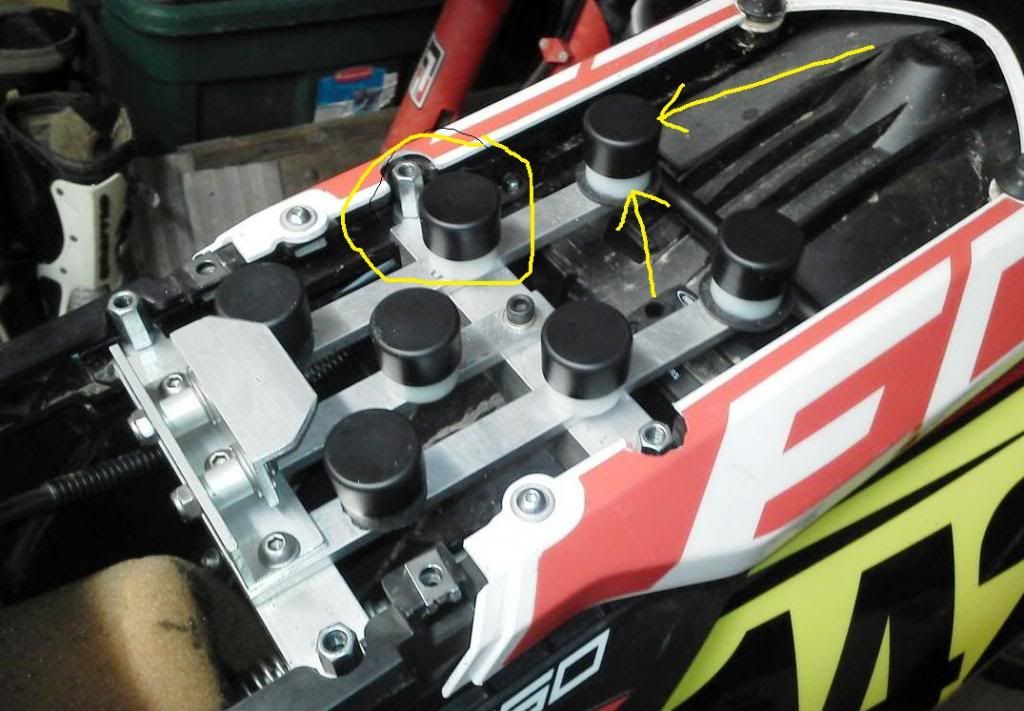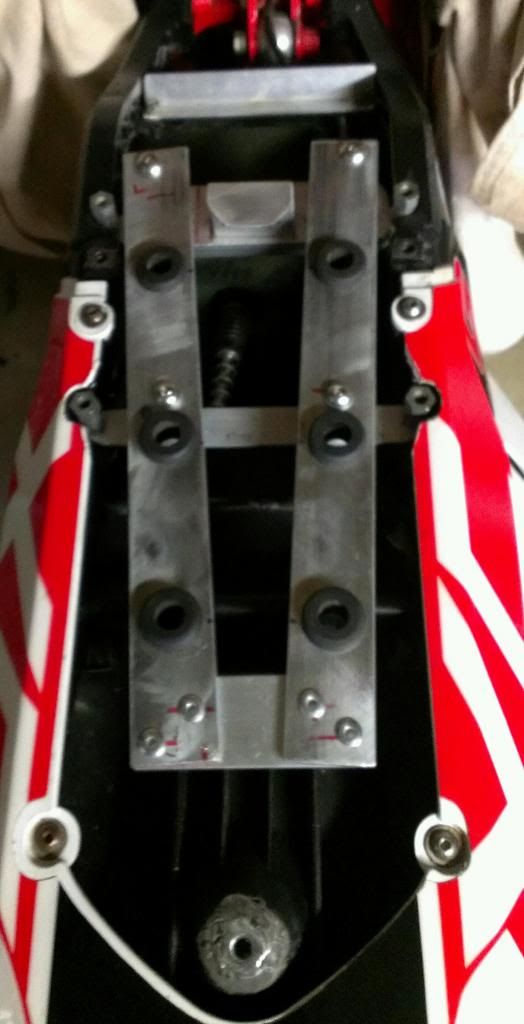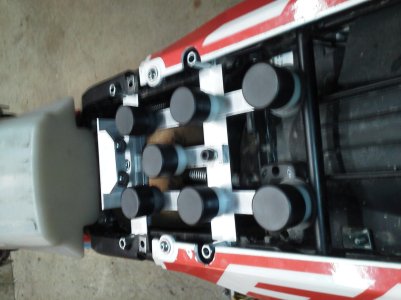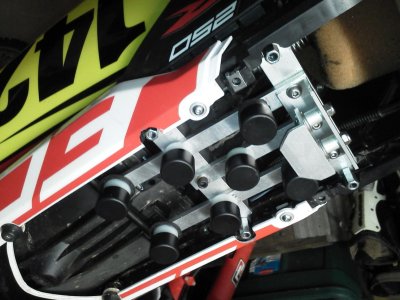Last edited:
You are using an out of date browser. It may not display this or other websites correctly.
You should upgrade or use an alternative browser.
You should upgrade or use an alternative browser.
'012 Subframe/seat brace
- Thread starter gasgasman
- Start date
StuJohnson
New member
GMP
Did you build this?
Would you be willing to share your design?
Did you build this?
Would you be willing to share your design?
GMP
Active member
You can do as you wish. I never even made a formal drawing, just measured and cut as I went as I was in a hurry. If I have time I could measure and make a parts list. Its pretty self explanatory from the pics. The idea is to support the seat base over the widest area practically possible, while connecting the subframe halves together for strength and not impeding airflow. If you have access to a mill, or even patience with a saw, you could make the entire frame from one piece of alloy plate. I did it all by hand from bar and angle stock.
StuJohnson
New member
You can do as you wish. I never even made a formal drawing, just measured and cut as I went as I was in a hurry. If I have time I could measure and make a parts list. Its pretty self explanatory from the pics. The idea is to support the seat base over the widest area practically possible, while connecting the subframe halves together for strength and not impeding airflow. If you have access to a mill, or even patience with a saw, you could make the entire frame from one piece of alloy plate. I did it all by hand from bar and angle stock.
Glenn
Thanks for the response. No need to get dimensions. It is all pretty simple.
My only question is what did you use for the seat supports?
I drew some arrow to the parts that I am not quite sure what you used.

GMP
Active member
Nylon 66 spacer, 1" H x 1" W x .5" ID, Mcmaster # 94639A880 $11.94 /25
Polyethelene pipe cap, 1", Mcmaster # 9567K14, $7.58 / 100
These are retained by an M6 bolt, nut, washer, and a short piece of rubber fuel line that expands when the bolt is tightened. The idea of the cap is to allow fine adjustment of the height with washers between the cap and spacer. You want the seat base to just contact the cap. You can see this by looking from the side. I also added a short M6 screw, nut as a locknut, and .5" cap to the top of the coupler nut that retains the brace or original batt box. This is also adjusted to just contact the side of the seat base. The idea is to provide support to the sides of the seat, preventing that flex and rolling feeling when you shift your weight to the side.
The result is a 100% improvement and elimination of that cheap feel to the seat.
If you have access to a shop there are many ways to do this. These parts allow a quick off the shelf solution.
Polyethelene pipe cap, 1", Mcmaster # 9567K14, $7.58 / 100
These are retained by an M6 bolt, nut, washer, and a short piece of rubber fuel line that expands when the bolt is tightened. The idea of the cap is to allow fine adjustment of the height with washers between the cap and spacer. You want the seat base to just contact the cap. You can see this by looking from the side. I also added a short M6 screw, nut as a locknut, and .5" cap to the top of the coupler nut that retains the brace or original batt box. This is also adjusted to just contact the side of the seat base. The idea is to provide support to the sides of the seat, preventing that flex and rolling feeling when you shift your weight to the side.
The result is a 100% improvement and elimination of that cheap feel to the seat.
If you have access to a shop there are many ways to do this. These parts allow a quick off the shelf solution.
modette
New member
Neat stuff...I looked for fun to see shipping cost...LOL 89.20 Euro's...LOL No thank you
StuJohnson
New member
Nylon 66 spacer, 1" H x 1" W x .5" ID, Mcmaster # 94639A880 $11.94 /25
Polyethelene pipe cap, 1", Mcmaster # 9567K14, $7.58 / 100
These are retained by an M6 bolt, nut, washer, and a short piece of rubber fuel line that expands when the bolt is tightened. The idea of the cap is to allow fine adjustment of the height with washers between the cap and spacer. You want the seat base to just contact the cap. You can see this by looking from the side. I also added a short M6 screw, nut as a locknut, and .5" cap to the top of the coupler nut that retains the brace or original batt box. This is also adjusted to just contact the side of the seat base. The idea is to provide support to the sides of the seat, preventing that flex and rolling feeling when you shift your weight to the side.
The result is a 100% improvement and elimination of that cheap feel to the seat.
If you have access to a shop there are many ways to do this. These parts allow a quick off the shelf solution.
Glenn
My seat fix support is not nearly as fancy looking as yours. But it is now 10 times better then that plastic battery box that was compressed and starting to crack. Thanks for your idea I was able to modify mine.
On a side note - In order to save my marriage I am no longer going to do any more mod's to my bike...... ;-)

Last edited:
GMP
Active member
That's good! As long as its stiff enough and the grommets contact the seat base. I used what I had around as far as stock and just bought the spacers. Don't forget the bolts and pipe caps added to the coupler nuts I mentioned, it really stops the "roll" feel of the seat by supporting the sides, like a conventional subframe.
Sent from my iPad using Tapatalk HD
Sent from my iPad using Tapatalk HD
StuJohnson
New member
That's good! As long as its stiff enough and the grommets contact the seat base. I used what I had around as far as stock and just bought the spacers. Don't forget the bolts and pipe caps added to the coupler nuts I mentioned, it really stops the "roll" feel of the seat by supporting the sides, like a conventional subframe.
Sent from my iPad using Tapatalk HD
Oh dam --- I totally missed that part about supporting the sides..... I will have to see how this works and then I can modify down the road.
Thanks again!!!!
GMP
Active member
You need the battery box. A friend of mine has a couple Yamaha WR250Fs. Awhile ago we started to look into an under engine LiOn or NiMh battery pack in a flat alloy waterproof enclosure between the frame rails(skid plate of course) to reduce weight and lower CG. Project kind of stopped when the kid went away to school and didn't ride much. Anyway it can be done if you think it out. Think two high capacity 7.2V R/C car packs in series for starters, or buy cells and make a custom pack. Make it a minimun size, good enough for a few restarts during a race. If I had to have an an estart bike for some reason, I would have to do something like this because that brick in the airbox design is just getting old and stupid for 2013 and would drive me crazy. I look at my brother's new Husky and think WTF? A simple two stroke thats quick to service and prep is a beautiful thing.
A simple two stroke thats quick to service and prep is a beautiful thing.
Similar threads
- Replies
- 6
- Views
- 5K
- Replies
- 1
- Views
- 5K



